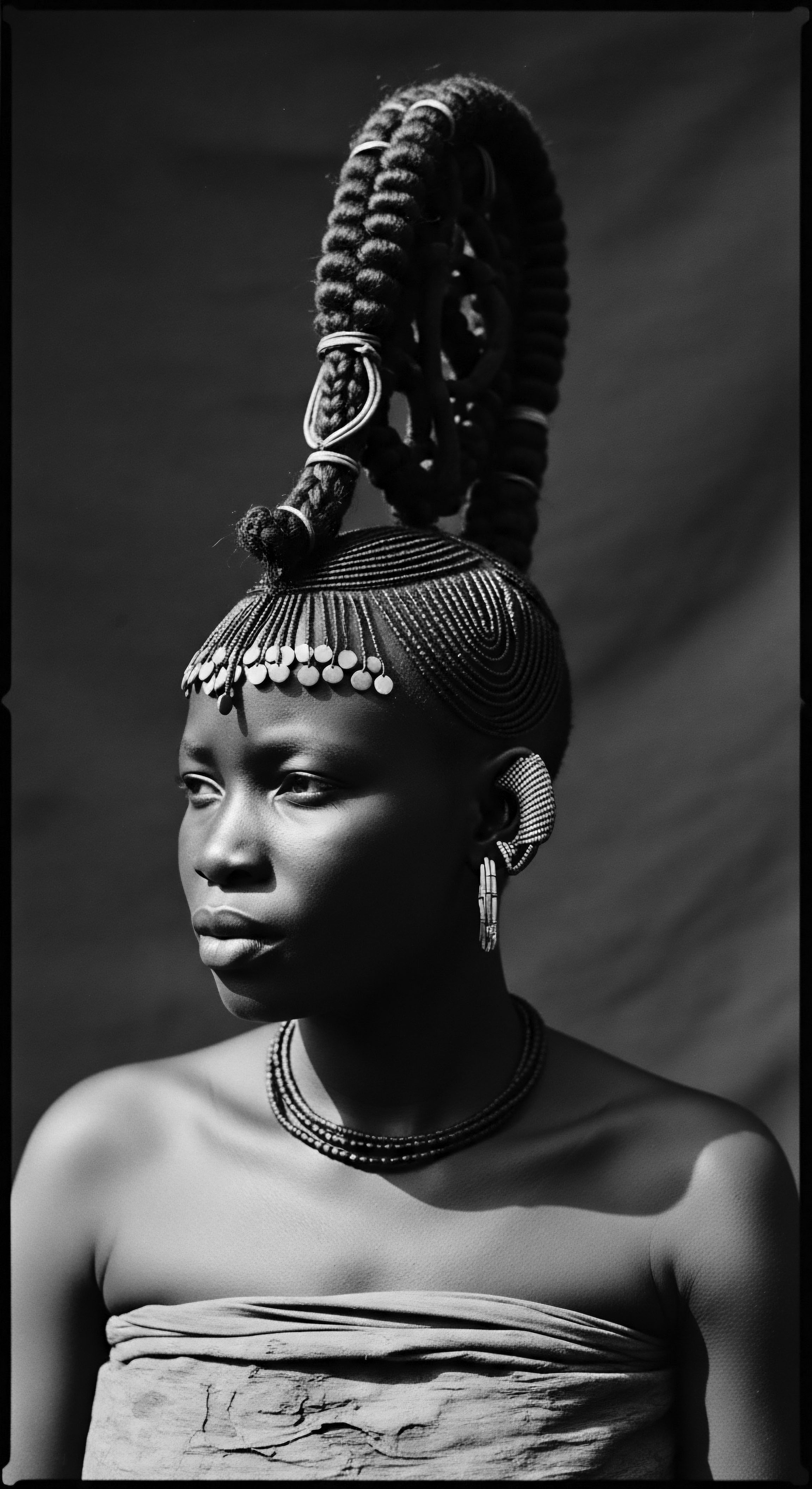
Fundamentals
The very notion of oil, particularly plant-derived elixirs, has always held a sacred place in the human story, a testament to our enduring connection with the earth’s offerings. Among these, Sesame Oil stands as a golden thread woven through the ancient tapestries of human civilization. Its identity, in its simplest form, refers to the vegetable oil carefully extracted from the seeds of the Sesamum indicum plant, a flowering annual. This unassuming seed, small yet potent, yields an oil revered for its distinct nutty aroma and a spectrum of hues, from a pale yellow to a deep, roasted brown, each color telling a tale of its processing and intended use.
From the earliest records, the meaning of sesame oil transcends mere culinary application. It has been a symbol of sustenance, a source of light, and a conduit for healing. The very act of pressing these tiny seeds to release their liquid gold speaks to an ancestral understanding of transformation and the harnessing of natural bounty.
Its fundamental significance lies in this dual role ❉ nourishing the body from within through consumption and nurturing the body’s exterior, including the hair and scalp, through topical application. This foundational understanding sets the stage for appreciating its deeper cultural and historical meaning, particularly for those whose heritage is intimately tied to natural hair care traditions.

Early Origins and Cultivation
The whispers of history suggest the sesame plant first took root in the fertile lands of India or Africa, with written accounts dating back to 3000 BCE. Some ancient Assyrian myths even speak of gods partaking in sesame seed wine before the very creation of the earth, imbuing the seed with a mythical, almost divine, connotation. From these origins, the cultivation of sesame spread across continents, finding homes in the Middle East, Asia, and eventually reaching the Americas. This global journey underscores its adaptability and the universal recognition of its value.
In ancient Egypt, the use of sesame oil was well-established by 1500 BCE, serving not only as a culinary staple but also for illuminating lamps in archaeological sites. Queen Cleopatra herself, a figure synonymous with ancient beauty rituals, incorporated sesame oil for skin and hair care, alongside other natural emollients. Such historical practices highlight that even in its earliest interpretations, sesame oil was understood as a versatile substance, its simple composition holding complex benefits for human wellbeing and adornment.
Sesame oil, in its most basic understanding, is the precious liquid extracted from the seeds of the Sesamum indicum plant, a natural bounty with a history stretching back millennia, prized for both nourishment and nurturing.

Initial Applications for Hair
Even in these nascent stages of human interaction with sesame, its application for hair care was recognized. Ancient texts and traditions speak of its use for maintaining hair health, preventing issues, and enhancing its natural qualities. This early awareness of its benefits for the scalp and strands forms the bedrock of its enduring legacy in hair traditions. The intuitive wisdom of ancestral communities observed how this golden oil brought shine, softness, and resilience to various hair textures, laying the groundwork for more sophisticated practices to come.
The inherent emollient properties of sesame oil, its ability to deeply moisturize, would have been evident even without modern scientific understanding. People simply observed the softening effect it had on hair, particularly on coarser or drier textures. This direct, experiential understanding is a crucial part of its foundational meaning, connecting us to the hands that first pressed the seeds and the heads that first received its gentle touch.

Intermediate
Stepping beyond its elemental identification, the intermediate understanding of sesame oil reveals a more intricate narrative, one that marries its biological composition with its profound cultural significance, particularly for textured hair. This deeper interpretation clarifies its role not merely as an ingredient, but as a silent partner in the preservation of hair heritage across generations. The meaning of sesame oil, in this context, becomes synonymous with ancestral wisdom, a living testament to intuitive botanical knowledge passed down through time.

Biochemical Profile and Hair Affinity
At a more discerning level, the efficacy of sesame oil for hair care stems from its rich biochemical composition. It is a veritable treasury of essential fatty acids, notably Linoleic Acid and Oleic Acid, alongside a wealth of vitamins, including Vitamin E and B-complex, and vital minerals such as magnesium, calcium, phosphorus, and zinc. These constituents are not randomly assembled; they work in concert to provide specific benefits that resonate deeply with the unique needs of textured hair.
- Fatty Acids ❉ Linoleic and oleic acids, being deeply penetrative, help to seal moisture within the hair shaft, a critical function for textured strands often prone to dryness due to the winding path natural oils must travel from the scalp. This capacity for deep hydration contributes significantly to the hair’s suppleness and resistance to breakage.
- Vitamin E ❉ As a potent antioxidant, Vitamin E combats oxidative stress, protecting hair from environmental aggressors like UV radiation and pollutants. This shielding action is particularly valuable for hair that may be exposed to harsh climates, as was often the case for ancestral communities living close to the land.
- Minerals ❉ Zinc, magnesium, and calcium contribute to overall scalp health, supporting robust hair growth and helping to regulate sebum production. A balanced scalp environment is foundational for strong, healthy hair, a truth recognized intuitively by those who practiced traditional oiling rituals.
The presence of unique compounds like Sesamin and Sesamolin further distinguishes sesame oil. These lignans possess anti-inflammatory properties, offering a soothing balm to an irritated scalp, which can be a common concern for textured hair types, especially when subjected to protective styling or environmental stressors. This inherent capacity for soothing and protection aligns with the gentle, preventative approach often seen in ancestral hair care.

The Tender Thread ❉ Ancestral Practices and Community
The narrative of sesame oil’s intermediate meaning extends beyond its molecular make-up to the living traditions that elevated it. Across Africa, India, and the diaspora, the application of oils to hair was, and remains, a deeply cherished practice, often imbued with cultural and communal significance. These practices were not merely cosmetic; they were acts of care, connection, and cultural continuity.
In traditional African societies, for instance, women massaged their scalps with various oils to maintain hair health and protect against environmental elements. While specific mentions of sesame oil might be less ubiquitous in some African contexts compared to shea butter or palm oil, its historical presence on the continent and its use in blends like Somali Karkar Oil affirm its place within this broader heritage of natural hair care. Karkar oil, a traditional hair growth oil from Somalia, includes sesame oil as a core ingredient, combined with ostrich oil, cow fat, and honey wax. This demonstrates how sesame oil became integrated into localized, community-specific formulations, adapted to regional needs and available resources.
Sesame oil’s intermediate significance lies in its biochemical richness, providing deep hydration and protection, properties intuitively understood and woven into ancestral hair care rituals across diverse cultures.
In India, the ancient system of Ayurveda reveres sesame oil as the “most commendable” of oils, often serving as the base for numerous medicated and fragrant hair oils. The practice of Shiro Abhyanga, a warm oil scalp massage, utilizing sesame oil, is a cornerstone of Ayurvedic hair care, believed to nourish the roots, improve circulation, and promote overall hair health. This ritualistic application speaks to a holistic approach to well-being where hair care is intertwined with mental tranquility and spiritual balance. The very Sanskrit word Sneha, meaning both ‘to oil’ and ‘to love,’ beautifully captures the profound emotional connection embedded within these practices.
The trans-Atlantic slave trade, while disrupting many ancestral practices, could not extinguish the deep-seated knowledge of hair care. Enslaved Africans reportedly brought sesame to the Americas in the 1600s, carrying with them not just the seeds, but the embodied knowledge of their uses. This enduring legacy speaks to the resilience of cultural traditions, where the careful application of natural oils, including sesame, continued to serve as a means of maintaining health, asserting identity, and fostering community amidst immense adversity. The simple act of oiling hair became a quiet act of resistance and continuity.

Adapting to Diverse Hair Needs
The unique structural characteristics of textured hair—its coily, kinky, and wavy patterns—often mean that natural sebum struggles to travel down the entire hair shaft, leading to inherent dryness. Sesame oil’s ability to deeply moisturize and form a protective layer around the strands directly addresses this fundamental need. Its lightweight texture, when compared to some heavier oils, ensures it can coat and condition each strand without imparting a greasy residue, making it suitable for a wide range of textured hair types. This adaptability allowed it to be integrated into diverse care regimens, from pre-wash treatments to leave-in conditioners, reflecting its versatility in ancestral and contemporary applications.
| Traditional Application (Heritage Root) Scalp Massage (Abhyanga/Communal Care) ❉ Warm oil massaged into the scalp to stimulate circulation and nourish roots, often a bonding ritual. |
| Modern Interpretation (Scientific Link) Follicle Stimulation & Nutrient Delivery ❉ Improves blood flow to hair follicles, supplying vital nutrients and antioxidants (Vitamin E, zinc) for healthy growth and reduced inflammation. |
| Traditional Application (Heritage Root) Pre-Wash Treatment (Protection) ❉ Applied before cleansing to protect strands from stripping and maintain moisture. |
| Modern Interpretation (Scientific Link) Moisture Retention & Frizz Reduction ❉ Creates a protective barrier, locking in moisture and smoothing the cuticle, which is crucial for preventing dryness and frizz in textured hair. |
| Traditional Application (Heritage Root) Hair Darkening/Premature Graying Prevention ❉ Used to retain natural hair color and combat early graying, particularly with black sesame oil. |
| Modern Interpretation (Scientific Link) Antioxidant Action & Melanin Support ❉ Antioxidants (sesamin, sesamolin) fight free radicals that contribute to cell damage and premature graying, supporting natural pigment production. |
| Traditional Application (Heritage Root) These applications demonstrate the enduring wisdom of ancestral practices, often finding validation in contemporary scientific understanding of sesame oil's benefits for textured hair. |

Academic
The academic delineation of sesame oil, particularly when viewed through the profound lens of textured hair heritage, transcends superficial benefits to examine its deeper mechanisms, its historical entanglements, and its symbolic resilience. Here, the meaning of sesame oil is not merely descriptive; it is an analytical interpretation, grounded in ethnobotanical inquiry, historical sociology, and the nuanced chemistry of natural emollients. This section seeks to provide a comprehensive exploration, scrutinizing the interwoven threads of ancient wisdom and modern scientific validation, specifically highlighting its profound impact on Black and mixed-race hair experiences.

The Unbound Helix ❉ Biocultural Adaptations and Ancestral Ingenuity
The journey of Sesamum indicum across continents is a compelling narrative of biocultural adaptation. Originally cultivated in diverse regions of Africa and India, the plant’s seeds and their extracted oil became indispensable not only for culinary purposes but also for their perceived medicinal and cosmetic properties. For communities with textured hair, living in climates that often presented environmental challenges such as intense sun, dry air, or humidity, the intrinsic properties of sesame oil offered a vital solution.
The oil’s ability to form a protective film, its natural SPF-like qualities, and its deep moisturizing capacity would have been intuitively recognized as essential for maintaining hair integrity. This ancestral ingenuity, often dismissed as mere folk practice, represents a sophisticated understanding of botanical resources and their application to specific physiological needs, honed over millennia.
Consider the broader historical context of oils in African hair care. While shea butter and palm oil might often take center stage in popular discourse, the presence and utility of sesame oil, particularly in regions like the Horn of Africa, offer a more complex picture. For instance, in Somalia, the traditional preparation of Karkar Oil provides a compelling case study. This compound oil, central to Somali hair care rituals, explicitly lists sesame oil as a primary ingredient.
Its inclusion alongside components like ostrich oil, cow fat, and honey wax speaks to a localized, expert formulation, where each element contributed to a synergistic effect aimed at length retention, breakage reduction, and overall scalp health for highly textured hair. This is not a random concoction; it is a meticulously developed blend, reflecting generations of observation and refinement within a specific cultural context.
The academic lens reveals sesame oil as a testament to ancestral ingenuity, a biocultural adaptation whose properties were intuitively understood and meticulously integrated into diverse hair care systems, especially for textured strands.
The transportation of sesame seeds from Africa to the Americas during the transatlantic slave trade, beginning in the 17th century, further underscores its historical significance. This forced migration meant that enslaved individuals carried with them not only their physical bodies but also their intangible cultural heritage, including knowledge of plants and their medicinal and cosmetic applications. The continuity of hair oiling practices, often with adapted ingredients, became a subtle yet powerful act of cultural preservation and resistance. While direct historical records detailing the precise prevalence of sesame oil use among enslaved Black communities in the Americas for hair care are scarce due to the systematic erasure of cultural practices, its documented arrival and existing traditional uses in the Caribbean and Southern United States (e.g.
as a demulcent drink from sesame leaves) suggest its continued presence and adaptation within diasporic wellness traditions. This speaks to the resilience of inherited knowledge, where ancestral wisdom, even when fragmented, found new expressions.

Chemical Symbiosis and Scalp Microbiome Harmony
From a biochemical perspective, the academic interpretation of sesame oil’s benefits for textured hair delves into its interaction with the scalp’s delicate ecosystem. The fatty acid profile of sesame oil, particularly its balance of omega-6 and omega-9 fatty acids, offers more than just surface-level conditioning. These lipids are critical for maintaining the integrity of the skin barrier on the scalp, preventing transepidermal water loss, a common challenge for dry, coily textures.
Furthermore, the oil’s antibacterial and antifungal properties, attributed to compounds like sesamin, contribute to a balanced scalp microbiome. A healthy scalp environment is paramount for fostering robust hair growth and mitigating common issues like dandruff and irritation, which can be particularly pronounced in dense, textured hair where air circulation might be limited.
A lesser-cited but compelling aspect of sesame oil’s action relates to its potential impact on hair pigmentation. Research suggests that the antioxidants present in black sesame seeds, specifically Sesamin and Sesamolin, may combat cellular damage responsible for premature graying. These compounds are believed to help preserve the hair’s natural pigment by influencing melanin production, offering a scientific explanation for the long-held traditional belief in sesame oil’s hair-darkening qualities, especially when derived from black sesame seeds. This observation, deeply embedded in Ayurvedic and Traditional Chinese Medicine practices, points to a sophisticated understanding of plant-based remedies addressing not just hair structure but also its intrinsic color.
The therapeutic application of sesame oil extends to its role as a carrier oil in herbal formulations. In Ayurvedic traditions, sesame oil serves as the base for approximately 90% of medicated oil treatments, chosen for its ability to penetrate deeply and transport the properties of infused herbs. This capacity for permeation means that when sesame oil is combined with traditional herbs like amla, bhringraj, or hibiscus, its efficacy is amplified, delivering targeted nourishment and therapeutic effects directly to the hair follicles and scalp. This synergistic interaction highlights a profound understanding of pharmacognosy within ancestral systems, where the oil acts as a bio-enhancer for other botanical ingredients.
Consider the intricate practice of hair oiling within South Asian households, often passed down through generations. Elders frequently massage oil into the scalps of younger family members, a ritual of both hair care and bonding. This intergenerational transfer of knowledge is not merely anecdotal; it represents a living pedagogy of hair wellness. A study by K.
P. Ravikumar (2017) on the importance of sesame oil in herbal oil formulations, while focusing broadly on its medicinal uses, reinforces its established role as a primary vehicle for herbal remedies due to its penetrating and nourishing qualities. This academic recognition of its “vehicle” property validates centuries of traditional practice where sesame oil was chosen precisely for its ability to deliver the benefits of other botanicals deep into the scalp and hair. This underscores the deliberate and informed choices made by ancestral practitioners, even without the language of modern chemistry.
- Penetrative Capacity ❉ The molecular structure of sesame oil allows for deeper penetration into the hair shaft and scalp, surpassing many other oils in its ability to deliver nutrients directly to the follicles. This attribute makes it an ideal base for medicated hair treatments, ensuring that the beneficial compounds reach their intended targets effectively.
- Antioxidant Richness ❉ The unique lignans, sesamol and sesamolin, provide powerful antioxidant activity, safeguarding hair and scalp cells from oxidative damage caused by environmental stressors. This protective shield is particularly relevant for preserving the vitality and youthful appearance of textured hair.
- Anti-Inflammatory Effects ❉ Sesame oil’s anti-inflammatory properties offer a soothing effect on irritated scalps, addressing common concerns like dryness, itching, and flakiness often experienced by individuals with textured hair. A calm, healthy scalp is the bedrock for flourishing hair.
- Melanin Support ❉ The presence of copper and other nutrients, particularly in black sesame oil, is linked to its traditional use in preventing premature graying by potentially supporting melanin production. This ancestral observation finds resonance in the scientific understanding of cellular processes.

Beyond the Strand ❉ Socio-Cultural Implications and Identity
The academic exploration of sesame oil’s meaning within textured hair heritage also encompasses its socio-cultural implications. Hair, especially textured hair, has historically served as a profound marker of identity, status, and spiritual connection within Black and mixed-race communities. The ritualistic care of hair, often involving oils like sesame, became a powerful means of expressing cultural belonging and maintaining self-esteem in the face of colonial pressures and systemic oppression.
The enduring practice of hair oiling, even in the diaspora, represents a conscious or unconscious act of reconnecting with ancestral ways of knowing and being. It is a tangible link to a past where self-care was communal care, where botanical wisdom was embodied knowledge, and where hair was a sacred extension of the self. The choice to utilize natural ingredients like sesame oil, rooted in ancient traditions, can be seen as a form of cultural reclamation, a deliberate assertion of identity that honors the resilience and beauty of Black and mixed-race hair.
This is not simply about physical conditioning; it is about psychological and spiritual nourishment, a continuation of a legacy of care that transcends generations. The simple act of massaging sesame oil into the scalp becomes a meditation on heritage, a quiet conversation with ancestors, and a reaffirmation of the inherent beauty of one’s natural self.
| Cultural Context Ancient Egypt |
| Significance of Sesame Oil Used for skin and hair moisturizing, often by royalty, signifying beauty and health. |
| Cultural Context Ayurveda (India) |
| Significance of Sesame Oil Deemed "most commendable," base for medicated oils, integral to scalp massage (Shiro Abhyanga) for nourishment and balance. |
| Cultural Context Traditional African Societies (e.g. Somalia) |
| Significance of Sesame Oil Integrated into compound oils like Karkar oil for growth, moisture, and scalp protection, reflecting localized botanical wisdom. |
| Cultural Context Traditional Chinese Medicine (TCM) |
| Significance of Sesame Oil Black sesame seeds/oil used for hair growth and preventing graying, connected to internal balance and vitality. |
| Cultural Context African Diaspora (e.g. Caribbean, Southern US) |
| Significance of Sesame Oil Carried through ancestral memory, adapted and continued in hair care, representing cultural continuity and resilience. |
| Cultural Context The consistent presence of sesame oil across these diverse cultural landscapes underscores its universal recognition and specialized application in hair care traditions. |

Reflection on the Heritage of Sesame Oil
As we close the living archive on sesame oil, a profound sense of continuity settles upon us, affirming its enduring presence within the Soul of a Strand. This golden elixir, born from the earth’s quiet wisdom, has traversed epochs and oceans, always finding its way to the textured coils and intricate braids that define so much of Black and mixed-race heritage. Its story is not simply one of chemical composition or historical anecdote; it is a resonant echo of hands that nurtured, communities that shared, and spirits that persevered. The significance of sesame oil, in its truest meaning, is intrinsically linked to the resilience of traditions that refused to be severed, even when uprooted.
The very act of applying sesame oil to textured hair today is a sacred communion, a gentle acknowledgment of the ancestral pathways that paved the way for our contemporary understanding of hair wellness. It is a moment where science bows to ancient wisdom, and where the past breathes life into the present. The tender touch of oil on scalp, the slow, deliberate massage, the feeling of nourishment sinking into each strand – these are not merely physical sensations. They are invitations to connect with a lineage of care, a testament to the profound relationship between self, nature, and inherited identity.
This oil reminds us that our hair is a living library, each curl and kink holding stories of resilience, beauty, and the unbroken spirit of those who came before us. It whispers of a time when hair was not just an adornment, but a spiritual antenna, a symbol of communal bonds, and a canvas for cultural expression.
Looking forward, the heritage of sesame oil serves as a guiding light, encouraging us to seek knowledge that honors both the scientific and the soulful. It urges us to remember that true wellness extends beyond superficial remedies, reaching into the deep roots of our collective past. For textured hair, this means recognizing that the ancient oils, the traditional practices, and the inherited wisdom are not relics of a bygone era, but vibrant, living tools for cultivating health, celebrating authenticity, and shaping a future where every strand tells a story of strength and beauty. The journey of sesame oil continues, an eternal testament to the power of nature’s gifts and the enduring legacy of textured hair.

References
- de Carvalho, M. A. A. et al. (2001). Sesame ❉ Botany, Production, and Uses. CABI Publishing.
- Dastur, J. F. (1952). Medicinal Plants of India and Pakistan ❉ A Compendium of Indian Medicinal Plants. D.B. Taraporevala Sons & Co.
- Morton, J. F. (1981). Atlas of Medicinal Plants of Middle America ❉ Bahamas to Yucatan. Charles C. Thomas Publisher.
- Quasem, J. M. et al. (2009). Medicinal Plants in Jordan. Yarmouk University.
- Ravikumar, K. P. (2017). Importance of Sesame Oil in Herbal Oil Formulation ❉ A Review Article. International Journal of Research in Pharmacy and Pharmaceutical Sciences, 2(6), 59-63.
- Salunkhe, D. K. et al. (1991). World Oilseeds ❉ Chemistry, Technology, and Utilization. Van Nostrand Reinhold.
- Suja, K. P. et al. (2004). Antioxidant Activity of Sesame (Sesamum indicum) Seeds. Food Chemistry, 84(3), 393-400.
- Trivedi, B. P. (1965). Indian Medicinal Plants. Chaukhamba Sanskrit Series Office.
- Voeks, R. A. & Rashford, J. (2012). African Ethnobotany in the Americas. Springer.
- Watt, G. (1889-1896). A Dictionary of the Economic Products of India. W. H. Allen & Co.
